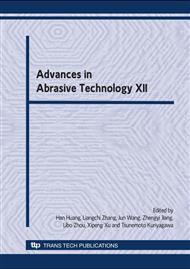p.3
p.9
p.15
p.21
p.27
p.33
p.38
p.43
Effects of Vibration-Assisted Grinding on Wear Behavior of Vitrified Bond Al2O3 Wheel
Abstract:
The total removal of grinding wheel material includes two main parts. The larger of the two is the result of dressing and truing operation and the other relatively small part is due to the wheel wear which takes place during the actual grinding process. The frequency of dressing and truing operations depends on the cutting conditions, wheel characteristic, etc. However in dry grinding as there is no cutting fluid to transfer the heat from the contact zone, the wheel wear during grinding and the frequency of dressing is much higher due to the higher grinding forces and temperatures. Vibration grinding reduces wear of the grinding wheel during the process considerably and decreases the frequency of dressing operation significantly. Hence it increases the efficiency of the process and reduces the cost. The investigation carried out in the KSF institute shows the improvement on the surface roughness, reduction of the grinding forces, thermal damage of the ground surface and radial wear of the grinding wheel in case of using vibration grinding comparing to conventional grinding. The designed and developed ultrasonically vibrated workpiece holder and the experimental investigation show a decrease of up to 80% of radial wear of the grinding wheel.
Info:
Periodical:
Pages:
21-26
Citation:
Online since:
June 2009
Price:
Сopyright:
© 2009 Trans Tech Publications Ltd. All Rights Reserved
Share:
Citation:


